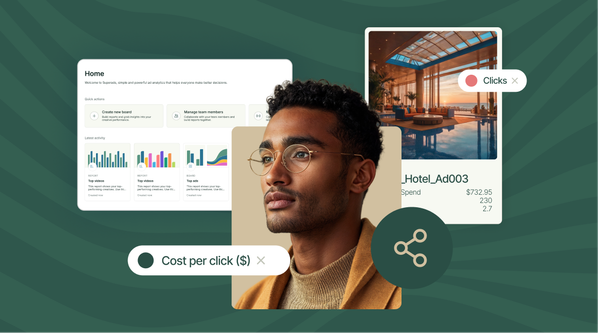5 Keys to Scale Success in Enterprise Creative Operations


Scaling up creative operations quickly and efficiently is essential for a growing enterprise. This guide explores the key strategies for achieving scalable success and the services that can assist you
The creative operations (or just “creative ops”) function aims to create a supportive environment where your team can handle the rising demand for creative work, helping them focus on their creative goals.
However, scaling your design output brings challenges. Producing more assets while maintaining brand identity and compliance standards, for example, requires quality management and increased resources.
The good news is that you can efficiently align your creative content with your expanding business goals by streamlining your creative operations. This article explores 5 ways of optimizing creative operations and the strategies, frameworks and services available to achieve the best outcomes.
What Are Creative Operations in an Enterprise Context?
A successful creative operations strategy manages the entire lifecycle of creative projects, from conception to delivery.
Creative operations include structured processes, tools and metrics to optimize quality, capacity and cost efficiency. They also include identifying and eliminating process bottlenecks, managing resources and budgets, and managing other variables involved in creative processes.
Creative operations vs. project management
Both creative operations and project management are vital for managing creative work, but they focus on different aspects and serve various purposes.
While creative operations provide a creative team with its backbone—structure, resources and processes to facilitate creativity—project management focuses on execution and delivery.
Project managers and creative ops managers have different roles, too. While the first handles specific tasks, such as setting deadlines and allocating resources, the latter focuses on broader systems, such as processing creative requests and ensuring brand compliance.
Why enterprises need scalable creative operations
When enterprises look to scale their creative output, traditional methods of managing production often fail. Whether you’re leading a global brand or a growing creative services division, the path to scalable success demands more than just adding headcount or implementing new tools. The key lies in transforming your creative operations.
Big brands must deploy creative across multiple channels to keep pace with today’s rapidly growing demand for quality creative output.
Coupled with the need to keep abreast of trends like location-based and personalized messaging, the complexity of big projects rises considerably.
Streamlined creative operations lead to marketing success. Enterprises can enhance efficiency, collaboration and quality across projects by optimizing creative workflows and establishing constructive feedback processes.
5 Key Strategies for Scalable Success in Creative Operations
Follow these five approaches to achieve successful, scalable creative outcomes spanning multiple projects.
1. Invest in a centralized creative operations framework
Establish a structured framework that outlines the creative process, from receiving briefs to executing the final product. Include:
- Clear workflows
- Defined roles
- Success metrics
- And guidelines for corporate and brand standards
The approach taken by Copper Giants, Liberty Mutual's in-house agency, is an excellent example. When Liberty Mutual began to scale up its creative output, Copper Giants knew it needed a better system for handling its entire creative workflow.
The team chose the work management platform Adobe Workfront to help them set up a creative operations framework. This enabled them to manage complex workflows and measure creative processes in-house while meeting increased production demand objectives.
2. Use data to optimize creative performance
Compelling creative assets are no longer enough. Today’s top brands use data analysis to optimize their assets and continuously boost their creative performance.
Here at Superside, for example, we use data to guide our every move. For instance, to assist in fine-tuning concepts to drive growth for fintech brand PointCard, Superside tested different design iterations and measured its performance against each asset using a “trust and learn” method. The creative outcome increased click-through rates (CTRs) by an impressive 240% and boosted conversions by 275%.
In another example, Superside helped identify an audience and quickly build trust for healthcare brand Kins by testing creative concepts across various channels and locations, supporting their local SEO strategy. As a result, Kins saw a 200% increase in CTR and a 40% saving for Facebook ads.
Want to skyrocket ad performance with the best reporting platform for ad creative? Sign up today to Superads and get data-driven insights from multiple socials about how your ad creative is doing and what you should keep and change to optimize your marketing strategy.
3. Standardize and automate workflows
Integrating AI and automation into content operations also helps streamline creative processes. Systemizing workflows, especially tedious tasks like feedback and approval loops, enhances efficiency and reduces bottlenecks.
Tools like Asana and Google Workspace are useful for managing content, but be wary of relying too heavily on software. Operating different tools can get messy, especially if the ones used by creative team members differ from those used by others.
Side note: If your teams do use multiple platforms, consider integration tools like Zapier to create automated connections (zaps). These notify team members in different departments through the platforms and messaging systems they use most frequently.
4. Foster cross-department collaboration
One challenge enterprises often face when delivering creative production at scale is streamlining the creative process across various teams. Ensuring that the creative work meets business goals can be tough when these teams don’t collaborate well.
Managing creative teams in enterprises involves bridging the gap between design and marketing. This is imperative for successful creative collaboration—a lesson we’ve learned the hard way.
Our streamlining suggestions:
- Integrate your creative processes into the company’s core values and avoid treating your design team as an afterthought.
- Synchronize team metrics, project management tools and processes. While teams can use different tools, they should understand each other’s work. The design team needs to know how marketing measures success—and marketing should be aware of design priorities, for example.
- Ensure team alignment on timelines, brand guidelines, flexibility and creative collaboration. Treat creative briefs as a starting point for discussion rather than strict commands.
5. Outsource to specialized creative partners
Even with a well-planned creative operations strategy, there will be times when your internal teams and processes can't keep up with demand.
This doesn’t have to be a roadblock, though. You can incorporate these busy periods into your planning by collaborating with external creative services or agencies to alleviate the pressure.
Or, you can also partner with Superside creatives to supply your own team's needs. With international teams allocated all over the world, our extensive work with big brands makes us one of the few companies capable of delivering the ideal combination of high-quality assets, rapid turnaround times and scalability.
Our outsourcing recommendations:
- Determine which tasks are worth outsourcing and why. Even if your internal creative team is excellent, some tasks will fall outside their expertise or are not the best use of their time.
- Identify the main design challenges facing your enterprise. Then, work with a creative services provider with the expertise to solve these issues.
- Consider how various outsourcing options support scaling design as an enterprise, especially if you want to expand into new markets and regions.
Sure, outsourcing creative work has its pros and cons. However, during busy periods, bringing in external partners who can deliver high-quality creative assets quickly is smart. It helps to ensure your team is well-prepared.
5 Top Services for Scaling Creative Operations in Enterprises
1. Superside
Superside stands out from other entries on this list because we don’t only provide tools; we’re a full-service design partner that simplifies scaling creative operations for growing enterprises.
We have plenty of experience developing creative operations strategies, so we have the tools and expertise to assist enterprises at any stage of their journey. Whether it's a framework for scaling an existing in-house design team or providing support for brands that don’t have one—like we did for health tech company Brio—supporting them with adaptable, consistent brand assets that go beyond a campaign: it represents its purpose.
We also collaborate with smaller teams, providing the insights and resources they need to achieve their creative goals. For example, our partnership with AEI Consultants transformed its one-person team into a strong creative force. Superside helped roll out marketing collateral, saving them 1,000 hours of design work while rebranding their company for a professional and cohesive presence.
Key features: Creative teams customized for enterprise needs, with scalable workflows and optional AI-assisted production.
Enterprise benefits: Superside can manage a high volume of creative requests while maintaining quality, making it an ideal choice for enterprises needing scalable creative solutions.
In short: Superside offers a complete creative solution. We can enhance existing creative operations teams or help you succeed without one efficiently and effortlessly.
2. Bynder
(Source: Bynder)
Bynder is primarily a digital asset management (DAM) platform, but it also provides multiple services designed to enhance creative operations. These include workflow tools for managing review and approval cycles, an automated digital content creation studio, and an analytics feature to assess asset performance.
The platform also offers built-in integrations with various project management and creative tools, such as Asana and Adobe Express. This combination of features makes Bynder a strong option for scaling your creative output. However, you'll still need an in-house team to produce your creative assets.
Key features: A centralized and configurable asset management system ensures brand consistency. It includes automation features for asset optimization, resizing and workflow automation.
Enterprise benefits: Bynder offers diverse tools, making it an excellent choice for enterprises favoring the advantages of creative scaling without outsourcing production.
3. Adobe Workfront
(Source: Adobe Workfront)
Adobe Workfront is a cloud-based work management solution with a "work better together" philosophy. This makes it ideal for supporting collaborative campaigns and optimizing creative project management. It also offers detailed automation features, such as email and data entry automation, benefitting teams looking to save time on tedious tasks.
Adobe Workfront is designed to manage every aspect of campaign planning through a centralized planning module. It focuses on optimizing workflows and tracking project outcomes. Additionally, it integrates seamlessly with various Adobe products, including Creative Cloud and the DAM tool Experience Manager Assets.
Key features: Custom workflow design using templates, comprehensive resource management dashboards and integrated GenAI support.
Enterprise benefits: Adobe Workfront is an excellent tool for enterprises, particularly those managing individual creative projects. Its value increases significantly if your in-house teams use the complete suite of connected Adobe products.
4. ICP
(Source: ICP)
ICP’s creative operations solution helps brands create content that fits their specific audience. It works with organizations to improve their processes and technology, enabling them to produce content quickly and at scale.
On this list, ICP and Superside are the only options that provide design services and creative operations. ICP offers small digital assets like banners and social media content, print and packaging designs, and motion graphics. It also provides change management and strategic planning support, making it a good choice for enterprises that need help implementing their creative operations strategy.
Key features: Flexible and innovative operations that support the integration of technology stacks with customized creative automation.
Enterprise benefits: ICP’s approach to creative operations is flexible and adaptable to enterprises' needs. This characteristic makes it a good fit for businesses with established processes and workflows that want to integrate with new systems.
5. Wrike
(Source: Wrike)
Wrike is a dedicated solution for creative teams in the technology, manufacturing and service industries. It aims to streamline every aspect of the creative process and offers pre-made templates that help busy professionals in creative operations quickly implement new workflows and initiatives.
Its platform provides a comprehensive suite of creative operations management tools for handling resources and workflows on a large scale. Wrike's platform is built for scalability, allowing complete customization to fit the needs of different enterprises. This flexibility enables organizations to promote collaboration and synchronize their geographically distributed teams.
Key features: Various analytics and data visualization tools, AI-driven workflow automation solutions and specialized resource management software.
Enterprise benefits: Wrike’s enterprise product tier offers pre-built workflow management options, making it ideal for businesses looking for a plug-and-play creative operations solution.
3 Challenges in Scaling Creative Operations
You’ll find the services we’ve listed invaluable in your quest to help your team build a solid creative operations strategy. However, as you grow, you might run into some common challenges.
Fortunately, Superside has the solutions to navigate them:
Challenge 1: Resource management and scalability
As your creative needs grow, managing them becomes more challenging, especially if your teams are spread across multiple locations. It's essential to regularly check your in-house capacity and proactively plan for any resource shortages.
Outsourcing creative work is one practical solution, and so is adopting new technology to help bridge any gaps.
Superside's solution
We address the resource management challenge in two ways:
First, Superside has experience working with businesses of all sizes, which gives us insight into the scaling process at various stages of growth. As a result, we’ve developed a well-honed toolkit that helps creative teams collaborate effectively across different departments.
Second, we leverage AI. Using AI tools is one of the most effective ways to help enterprises scale their creative operations in a fraction of the time. Embracing these tools can ensure you reach your burgeoning creative goals.
Challenge 2: Ensuring brand consistency
Every creative ops expert understands that maintaining a uniform brand voice and identity can be difficult, particularly when overseeing distributed teams. This dilemma grows as your initiatives expand. As a result, it's crucial to have a strategy ready to guarantee your brand stays authentic while speeding up bespoke content creation.
Superside's solution
As a provider of creative services with experience across various enterprises and campaigns, Supersiders understand that ensuring consistency for major brands is based on two essential principles: Cultivating strong, collaborative relationships among teams or organizations and ensuring all new creative assets follow established brand guidelines while remaining innovative and fresh.
A case in point: When publishing company Packt approached Superside, it wanted to refresh its brand identity and create consistent guidelines following rapid expansion. Our approach ensured Packt’s’ creative needs were met while maintaining the brand's integrity. This strategy enabled the brand to reconnect with its audience and establish a clear and concise new identity.
Similarly, Superside helped Satair, a global aircraft component and service company, achieve brand coherence as it scaled its operations over the years.
Challenge 3: Speed and agility in production
A significant challenge businesses encounter when scaling their creative efforts is meeting rising demand while maintaining streamlined and efficient operations.
No matter how well-organized your creative process is, it will break down without a strategy to address workflow bottlenecks and inefficiencies.
Superside's solution
We recognize that to scale up successfully, enterprises need to focus on both speed and efficiency. AI can make a big difference.
For instance, Superside combined AI and human creativity to produce a personalized image library for equipment management company National Gas Metering. The collaboration resulted in an 85% time savings and $11k cost savings.
Plus, AI opens up a whole world of innovative creativity, an essential consideration for scaling up efficiently. In this event-related case study, we used AI and our exceptional human talent to design and print 21 distinctive Pixar-style posters in record-breaking time.
Scaling Creative Operations With Superside
Scaling up is exciting, but it comes with challenges. The larger the enterprise, the greater the demands on in-house marketing and creative teams.
The strategies, tools and services we’ve discussed will support scalable creative operations in your growing business. If time and budget constraints hinder your progress, an outsourced solution to address your enterprise design challenges is your best bet.
Superside is unparalleled in scalability, quality and cost-effectiveness. Schedule a demo call to discover how we can give your brand wings to even more success.
Emanuel is a Content Specialist at Superside. With the knowledge that three languages (and counting) and digital marketing can serve a creator, he has helped B2Bs from multiple industries to write, optimize and scale their content game with compelling pieces that answers questions and solve problems. On Superside, Emanuel streamlines content ideas into powerful articles that guides you on how to use Superside multi-powered services to scale your business to the max.
You may also like these

7 top creative support solutions for teams and enterprises
There’s no denying that today’s marketing and creative teams are under more stress than ever. To deliver high-performing, top-quality assets at scale, many teams are getting fewer resources, smaller budgets and tighter deadlines.As an ever-increasing number of brands compete for audience attention, the demand for compelling content is getting higher—and essential for creative teams to meet.It’s no surprise then that in-house marketing and creative teams are turning to advanced creative support solutions to help enhance efficiency, streamline workflows and optimize production processes.From AI-powered design to cloud-based collaboration software and outsourced creative services, these solutions transform how teams work, allowing them to produce more assets faster without compromising quality.Our best advice to teams and enterprises on how to get this right? Make Superside your creative team’s creative team and free up your team to do their best work.
How to find creative partner agencies to boost 2025 strategy
Are your internal creatives battling to keep up as the demand for authentic, trustworthy content grows? For many brands, outsourcing creative makes sound financial sense. Plus, partnering with an experienced creative services team can bring fresh ideas and impressive scalability.80% of customers say that the experience a company provides is just as important as its products or services, meaning that driving great customer experiences is essential in 2025. Once again, creative partnerships pay dividends, as many creative agencies go well beyond KPIs to drive genuine cultural impact and build trust.Unlike traditional agencies, creative partner agencies also typically act as an extension of your team. Work with Superside, for example, and our talented designers will become your creative team’s creative team.
6 Social Media Design Trends Defining Engagement in 2025
In 2024, brands used engaging user-generated content (UGC) in their marketing strategies, with TikTok lookalike contests and the AI ‘90s yearbook challenge trend sparking significant social media engagement. Pepsi leaned into nostalgia for its rebrand, while Starface turned functional skincare into a fashion statement.In a content-saturated world, brands must keep up with social media graphic design trends to stand out and remain relevant. As converting followers into customers grows more challenging, creating distinctive, scroll-stopping content can help your brand cut through the noise.Collaborating with a fully managed team of creatives who understand the latest social media design trends is an excellent place to start.And who better to guide us through this year’s key trends than Superside’s Executive Creative Director, Kae Neskovic, and Juan Cistoldi, Creative Strategist.Let's dive in:

















